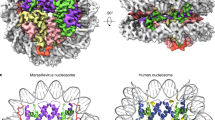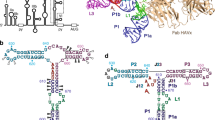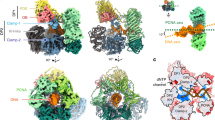Abstract
The nuclear factor of activated T cells (NFAT) and the AP-1 heterodimer, Fos–Jun, cooperatively bind a composite DNA site and synergistically activate the expression of many immune-response genes. A 2.7-Å-resolution crystal structure of the DNA-binding domains of NFAT, Fos and Jun, in a quaternary complex with a DNA fragment containing the distal antigen-receptor response element from the interleukin-2 gene promoter, shows an extended interface between NFAT and AP-1, facilitated by the bending of Fos and DNA. The tight association of the three proteins on DNA creates a continuous groove for the recognition of 15 base pairs.
This is a preview of subscription content, access via your institution
Access options
Subscribe to this journal
Receive 51 print issues and online access
$199.00 per year
only $3.90 per issue
Buy this article
- Purchase on Springer Link
- Instant access to full article PDF
Prices may be subject to local taxes which are calculated during checkout





Similar content being viewed by others
References
Weiss, A. & Littman, D. R. Signal transduction by lymphocyte antigen receptors. Cell 76, 263–274 (1994).
Crabtree, G. R. & Clipstone, N. A. Signal transmission between the plasma membrane and nucleus of T lymphocytes. Annu. Rev. Biochem. 63, 1045–1083 (1994).
Jain, J., Loh, C. & Rao, A. Transcriptional regulation of the IL-2 gene. Curr. Opin. Immunol. 7, 333–342 (1995).
Serfling, E., Avots, A. & Neumann, M. The architecture of the interleukin-2 promoter: a reflection of T lymphocyte activation. Biochim. Biophys. Acta 1263, 181–200 (1995).
Shaw, J. P. et al. Identification of a putative regulator of early T cell activation genes. Science 241, 202–205 (1988).
Rao, A., Luo, C. & Hogan, P. G. Transcription factors of the NFAT family: regulation and function. Annu. Rev. Immunol. 15, 707–747 (1997).
Schreiber, S. L. & Crabtree, G. R. The mechanism of action of cyclosporin A and FK506. Immunol. Today 13, 136–142 (1992).
McCaffrey, P. G. et al. Isolation of the cyclosporin-sensitive T cell transcription factor NFATp. Science 262, 750–754 (1993).
Northrop, J. P. et al. NF-AT components define a family of transcription factors targeted in T-cell activation. Nature 369, 497–502 (1994).
Masuda, E. S. et al. NFATx, a novel member of the nuclear factor of activated T cells family that is expressed predominantly in the thymus. Mol. Cell Biol. 15, 2697–2706 (1995).
Hoey, T., Sun, Y. L., Williamson, K. & Xu, X. Isolation of two new members of the NF-AT gene family and functional characterization of the NF-AT proteins. Immunity 2, 461–472 (1995).
Jain, J., Burgeon, E., Badalian, T. M., Hogan, P. G. & Rao, A. Asimilar DNA-binding motif in NFAT family proteins and the Rel homology region. J. Biol. Chem. 270, 4138–4145 (1995).
Chytil, M. & Verdine, G. L. The Rel family of eukaryotic transcription factors. Curr. Opin. Struct. Biol. 6, 91–100 (1996).
Shaw, K. T. et al. Immunosuppressive drugs prevent a rapid dephosphorylation of transcription factor NFAT1 in stimulated immune cells. Proc. Natl Acad. Sci. USA 92, 11205–11209 (1995).
Timmerman, L. A., Clipstone, N. A., Ho, S. N., Northrop, J. P. & Crabtree, G. R. Rapid shuttling of NF-AT in discrimination of Ca2+ signals and immunosuppression. Nature 383, 837–840 (1996).
Luo, C. et al. Interaction of calcineurin with a domain of the transcription factor NFAT1 that controls nuclear import. Proc. Natl Acad. Sci. USA 93, 8907–8912 (1996).
Shibasaki, F., Price, E. R., Milan, D. & McKeon, F. Role of kinases and the phosphatase calcineurin in the nuclear shuttling of transcription factor NF-AT4. Nature 382, 370–373 (1996).
Beals, C. R., Clipstone, N. A., Ho, S. N. & Crabtree, G. R. Nuclear localization of NF-ATc by a calcineurin-dependent, cyclosporin-sensitive intramolecular interaction. Genes Dev. 11, 824–834 (1997).
Liu, J. et al. Calcineurin is a common target of cyclophilin-cyclosporin A and FKBP-FK506 complexes. Cell 66, 807–815 (1991).
Jain, J., McCaffrey, P. G., Valge-Archer, V. E. & Rao, A. Nuclear factor of activated T cells contains Fos and Jun. Nature 356, 801–804 (1992).
Jain, J., Miner, Z. & Rao, A. Analysis of the preexisting and nuclear forms of nuclear factor of activated T cells. J. Immunol. 151, 837–848 (1993).
Cockerill, P. N. et al. Human granulocyte-macrophage colony-stimulating factor enhancer function is associated with cooperative interactions between AP-1 and NFATp/c. Mol. Cell. Biol. 15, 2071–2079 (1995).
Jain, J. et al. The T-cell transcription factor NFATp is a substrate for calcineurin and interacts with Fos and Jun. Nature 365, 352–355 (1993).
Muller, C. W., Rey, F. A., Sodeoka, M., Verdine, G. L. & Harrison, S. C. Structure of the NF-κB p50 homodimer bound to DNA. Nature 373, 311–317 (1995).
Ghosh, G., van Duyne, G., Ghosh, S. & Sigler, P. B. Structure of NF-κB p50 homodimer bound to a κB site. Nature 373, 303–310 (1995).
Wolfe, S. A. et al. Unusual Rel-like architecture in the DNA-binding domain of the transcription factor NFATc. Nature 385, 172–176 (1997).
Chen, L. et al. Only one of the two DNA-bound orientations of AP-1 found in solution cooperates with NFATp. Curr. Biol. 5, 882–889 (1995).
Bork, P., Holm, L. & Sander, C. The immunoglobulin fold. Structural classification, sequence pattens and common core. J. Mol. Biol. 242, 309–320 (1994).
Ellenberger, T. E., Brandl, C. J., Struhl, K. & Harrison, S. C. The GCN4 basic region leucine zipper binds DNA as a dimer of uninterrupted alpha helices: crystal structure of the protein-DNA complex. Cell 71, 1223–1237 (1992).
Konig, P. & Richmond, T. J. The X-ray structure of the GCN4-bZIP bound to ATF/CREB site DNA shows the complex depends on DNA flexibility. J. Mol. Biol. 233, 139–154 (1993).
Glover, J. N. & Harrison, S. C. Crystal structure of the heterodimeric bZIP transcription factor c-Fos-c-Jun bound to DNA. Nature 373, 257–261 (1995).
Seeman, N. C., Rosenberg, J. M. & Rich, A. Sequence-specific recognition of double helical nucleic acids by proteins. Proc. Natl Acad. Sci. USA 73, 804–808 (1976).
Pabo, C. O. & Sauer, R. T. Transcription factors: structural families and principles of DNA recognition. Annu. Rev. Biochem. 61, 1053–1095 (1992).
Chen, L. Functional and Structural Studies of DNA Binding Proteins. Thesis, Harvard Univ., ((1994)).
Sun, L. J., Peterson, B. R. & Verdine, G. L. Dual role of the nuclear factor of activated T cells insert region in DNA recognition and cooperative contacts to activator protein 1. Proc. Natl Acad. Sci. USA 94, 4919–4924 (1997).
Peterson, B. R., Sun, L. J. & Verdine, G. L. Acritical arginine residue mediates cooperativity in the contact interface between transcription factors NFAT and AP-1. Proc. Natl Acad. Sci. USA 93, 13671–13676 (1996).
Yamamoto, K. R., Pearce, D., Thomas, J. & Miner, J. N. in Transcriptional Regulation (eds McKnight, S. L. & Yamamoto, K. R.) 1169–1192 (Cold Spring Harbor Laboratory Press, NY, (1992)).
Johnson, A. in Transcriptional Regulation (eds McKnight, S. L. & Yamamoto, K. R.) 975–1006 (Cold Spring Harbor Laboratory Press, NY, (1992)).
Tjian, R. & Maniatis, T. Transcriptional activation: a complex puzzle with few easy pieces. Cell 77, 5–8 (1994).
Thanos, D. & Maniatis, T. Virus induction of human IFN beta gene expression requires the assembly of an enhanceosome. Cell 83, 1091–1100 (1995).
Garrity, P. A., Chen, D., Rothenberg, E. V. & Wold, B. J. Interleukin-2 transcription is regulated in vivo at the level of coordinated binding of both constitutive and regulated factors. Mol. Cell. Biol. 14, 2159–2169 (1994).
Otwinowski, Z. in Proceedings of the CCP4 study weekend (eds Sawyer, L., Isaacs, N. & Burley, S.) 56–62 (SERC Daresbury Laboratory, Warrington, (1993)).
Collaborative Computational Project Number 4.The CCP suite: Programs for protein crystallography. Acta Crystallogr. D 50, 760–776 (1994).
Hendrickson, W. A. Determination of macromolecular structures from anomalous diffraction of synchrotron radiation. Science 254, 51–58 (1991).
Jones, T. A., Bergdoll, M. & Kjeldgaard, M. in Crystallographic Computing and Modeling Methods in Molecular Design (eds Bugg, C. & Ealick, S.) (Springer, New York, (1989)).
Brunger, A. T. X-PLOR Version 3.0: A System for Crystallography and NMR (Yale Univ. Press, New Haven, CT, (1992)).
Kleywegt, G. & Jones, T. A. in From First Map to Final Model (eds Bailey, S., Hubbard, R. & Walker, D.) (Daresbury Laboratory, Warrington, (1994)).
Kraulis, P. J. MOLSCRIPT: a program to produce both detailed and schematic plots of protein structures. J. Appl. Crystallogr. 24, 946–950 (1991).
Nicholls, A., Sharp, K. A. & Honig, B. Protein folding and association: insights from the interfacial and thermodynamic properties of hydrocarbons. Proteins Struct. Funct. Genet. 11, 281–296 (1991).
Carson, M. Ribbons 2.0. J. Appl. Crystallogr. 24, 958–961 (1991).
Acknowledgements
We thank T. Hsieh, B. Willard and N. Sinitskaya for help with protein and DNA preparation; K. Leong, T. Stehle, J. Wang, R. Chopra and M. Jacobs for help with data collection and computation; J. Jain, G. Verdine, S. Wolfe, D. Erlanson, P. Zhou, L. Sun, B. Peterson and C. Vaughan for discussions; and L. Berman, Z. Yin and M. Soltis for synchrotron technical assistance. L.C. was supported by the Cancer Research Fund of the Damon Runyon-Walter Winchell Foundation Fellowship, and by The Medical Foundation. S.C.H. is an investigator of the Howard Hughes Medical Institute.
Author information
Authors and Affiliations
Corresponding authors
Rights and permissions
About this article
Cite this article
Chen, L., Glover, J., Hogan, P. et al. Structure of the DNA-binding domains from NFAT, Fos and Jun bound specifically to DNA. Nature 392, 42–48 (1998). https://doi.org/10.1038/32100
Received:
Accepted:
Issue Date:
DOI: https://doi.org/10.1038/32100
This article is cited by
-
Identifying the genetic and epigenetic basis for asymmetric bZIP expression in temperature-stressed bread wheat
Plant Growth Regulation (2024)
-
Glycogen synthase kinase 3 controls T-cell exhaustion by regulating NFAT activation
Cellular & Molecular Immunology (2023)
-
The JNK-EGR1 signaling axis promotes TNF-α-induced endothelial differentiation of human mesenchymal stem cells via VEGFR2 expression
Cell Death & Differentiation (2023)
-
Venetoclax imparts distinct cell death sensitivity and adaptivity patterns in T cells
Cell Death & Disease (2021)
-
The TLR-2/TonEBP signaling pathway regulates 29-kDa fibronectin fragment-dependent expression of matrix metalloproteinases
Scientific Reports (2021)
Comments
By submitting a comment you agree to abide by our Terms and Community Guidelines. If you find something abusive or that does not comply with our terms or guidelines please flag it as inappropriate.



